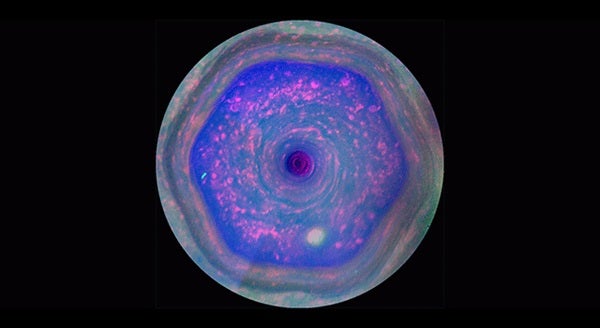This is the first hexagon movie of its kind, using color filters, and the first to show a complete view of the top of Saturn down to about 70° latitude. Spanning about 20,000 miles (30,000 kilometers) across, the hexagon is a wavy jet stream of 200 mph (about 300 km/h) winds with a massive rotating storm at the center. There is no weather feature exactly consistently like this anywhere else in the solar system.
“The hexagon is just a current of air, and weather features out there that share similarities to this are notoriously turbulent and unstable,” said Andrew Ingersoll from the California Institute of Technology in Pasadena. “A hurricane on Earth typically lasts a week, but this has been here for decades — and who knows — maybe centuries.”
Weather patterns on Earth are interrupted when they encounter friction from landforms or ice caps. Scientists suspect the stability of the hexagon has something to do with the lack of solid landforms on Saturn, which is essentially a giant ball of gas. Better views of the hexagon are available now because the Sun began to illuminate its interior in late 2012. Cassini captured images of the hexagon over a 10-hour time span with high-resolution cameras, giving scientists a good look at the motion of cloud structures within.
They saw the storm around the pole, as well as small vortices rotating in the opposite direction of the hexagon. Some of the vortices are swept along with the jet stream as if on a racetrack. The largest of these vortices spans about 2,200 miles (3,500km), or about twice the size of the largest hurricane recorded on Earth.
Scientists analyzed these images in false color, a rendering method that makes it easier to distinguish differences among the types of particles suspended in the atmosphere — relatively small particles that make up haze — inside and outside the hexagon.
“Inside the hexagon, there are fewer large haze particles and a concentration of small haze particles, while outside the hexagon, the opposite is true,” said Kunio Sayanagi from Hampton University in Virginia. “The hexagonal jet stream is acting like a barrier, which results in something like Earth’s Antarctic ozone hole.”
The Antarctic ozone hole forms within a region enclosed by a jet stream with similarities to the hexagon. Wintertime conditions enable ozone-destroying chemical processes to occur, and the jet stream prevents a resupply of ozone from the outside. At Saturn, large aerosols cannot cross into the hexagonal jet stream from outside, and large aerosol particles are created when sunlight shines on the atmosphere. Only recently, with the start of Saturn’s northern spring in August 2009, did sunlight begin bathing the planet’s northern hemisphere.
“As we approach Saturn’s summer solstice in 2017, lighting conditions over its north pole will improve, and we are excited to track the changes that occur both inside and outside the hexagon boundary,” said Scott Edgington from NASA’s Jet Propulsion Laboratory in Pasadena, California.
A black-and-white version of the imaging camera movie and movies obtained by Cassini’s visual and infrared mapping spectrometer are also tools Cassini scientists can use to look at wind speeds and the mini-storms inside the jet stream.










